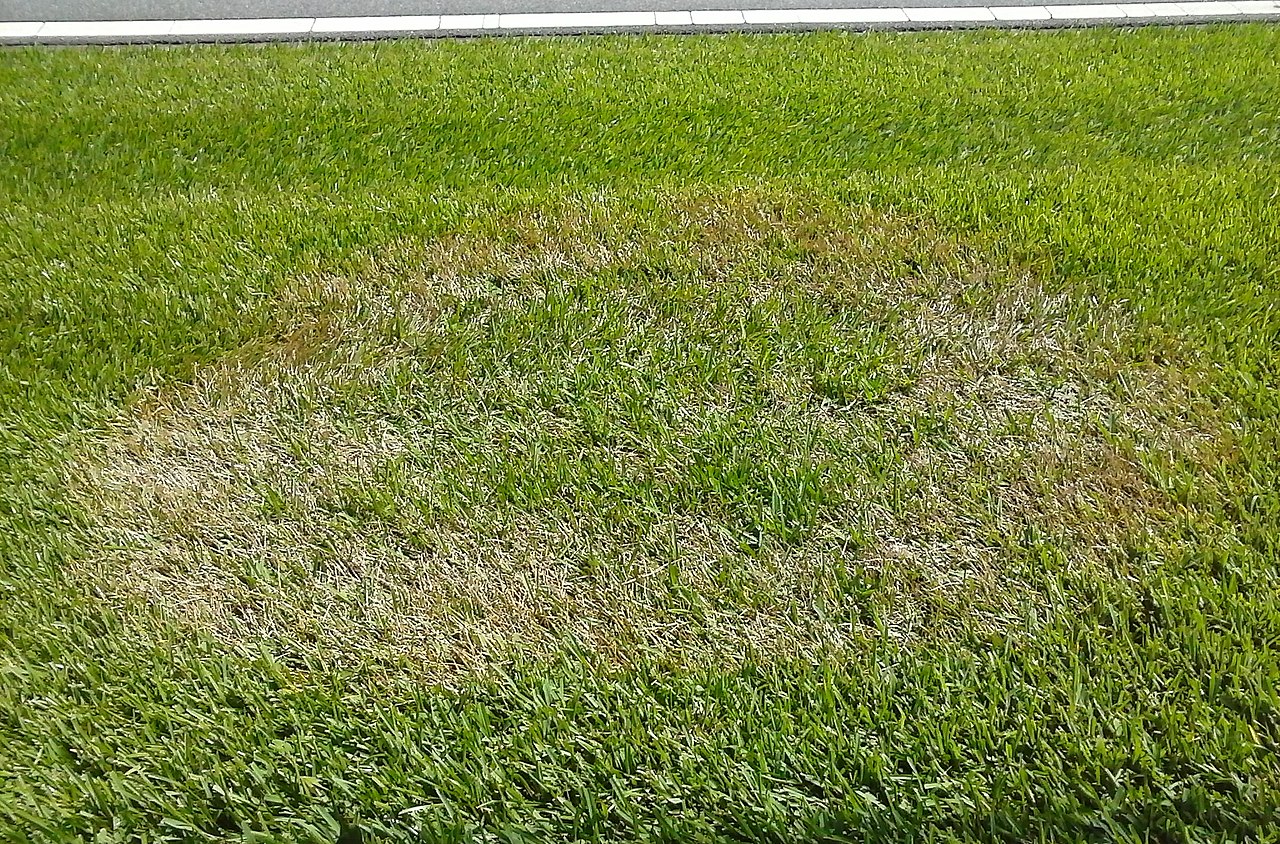
by admin | Aug 3, 2018 | Brown Patch, Lawn Chemical Treatment Rockwall
Seeing brown spots in your yard? We Texans live in a region with hot temperatures and high humidity, so you bet you may find your lawn infected with Brown Patch lawn disease.
Read below for some frequently asked questions regarding the lawn intruder and tips to get your lawn healthy again.
So, what is this disease?
Brown Patch lawn disease is a common and widespread problem caused by Rhizoctonia solani fungus. The disease can infect a variety of common turfgrasses but the most susceptible grass species include perennial ryegrass, tall fescue, and the bentgrasses.
Brown Patch can also become a problem to Kentucky bluegrasses in mid-to-late summer during extended periods of high temperature and humidity.
How do I know if my lawn has this disease?
The first step to identifying: Do you see spotting on your leaf blades? If you see spotting on your leaf blades—which can eventually bleed together to turn the entire leaf brown—suspect Brown Patch is invading your lawn.
More obvious signs are circular areas of brown and dead grass surrounded by a narrow, dark ring. Patches are typically irregular and can be quite large, as this disease can spread fast.
This spotting can take on different appearances depending on the characteristics of the grass it infects:
Closely mown grasses: Any grass you should cut short, like some Zoysias, will show circular rings of brown patches and an expanding gray ring on the outer edge—most noticeable when the grass is damp, especially in the early morning hours.
High-cut grasses: Grasses that are kept taller often exhibit circular or nearly circular brown areas, but without the visible details of gray exterior.
Tall fescue: Tall fescue varieties often don’t exhibit the characteristic circular patterns. Rather, the fungus will appear on scattered blades of grass, so that the whole lawn may seem a little “off,” with a tannish cast rather than the vibrant green you want to see.
Why is this showing up now?
Brown Patch thrives when hot weather and high humidity settle in during the summer months. Your yard can (and if you have it, most likely did) become infected during a period of cooler temperatures. The disease can take hold and develop well below 80 degrees Fahrenheit, but doesn’t spread and become apparent to the naked eye until temperatures and humidity levels rise. Dew, mist, or rain on leaf blades in these conditions can contribute to the rise of Brown Patch.
How can I get my lawn healthy again?
The fungus that causes Brown Patch lawn disease is present in many areas. Disease prevention is very difficult if the grass species is susceptible.
Proper watering in midday to prevent wet grass at night may be of some, but limited benefit. Proper mowing on a frequent basis to promote air movement and drying of the leaf blades may be of more benefit when battling Brown Patch.
Removing dew or guttation water that collects on the grass leaves each morning has proven effective as an aid in reducing brown patch. This removal can be achieved by mowing or by dragging a water hose across the area.
More tips for treating:
Use moderate amounts of nitrogenous fertilizer.
Fungicides can be effective if applied before the onset of the disease, but should only be used on high-value ryegrass or bentgrass turfs.
Don’t over- or under-fertilize your turf, as that can encourage Brown Patch.
Can I get help from a professional?
First Response Lawn Care specialists know exactly what your lawn needs and what changes you may need to make to achieve a lawn you’ll love. If you suspect your lawn is infected or you’re worried it may become so, give one of our specialists a call to set you up on a plan for a healthy lawn.
To schedule a consultation with one of our Lawn Treatment Specialists, call (214) 701-7622. You’ll be on your way to finding out how to remedy that sad, brown lawn, and rebuilding the healthy, green lawn you want.
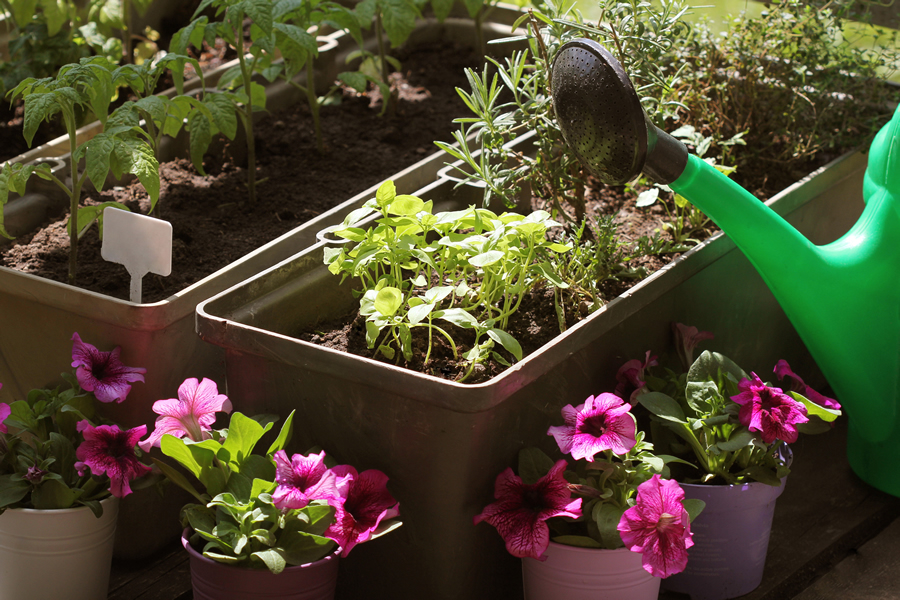
by admin | Jul 27, 2018 | Fall Vegetable Garden Prep, Fertilize Treatments Rockwall, Herbicides
August is the time to plant Fall vegetables. Set out transplants of broccoli, cauliflower, and collards. Sow seeds of beets, lettuce, English peas, spinach, turnips, and mustard.
The soil in your garden bed should be loose and easy to work. If it is not, add large amounts of compost or other organic amendments. You can use a tiller or a shovel to work the dirt.
Vegetables don’t have to have their own bed. You can intermingle them among established ornamental plants in your flowerbeds, or grow them in containers. The great thing about using containers is that you can move them at will to catch the proper amount of sunlight.
Vegetables do need lots of sunlight, generally at least six hours of direct sun. Those with edible roots – beets, carrots and radishes – plus broccoli and cauliflower can get by with an hour less sun. And leafy plants such as lettuce or spinach do better with protection from the hot afternoon sun.
Add a slow-release fertilizer if you haven’t fed the bed during the year. If you have, don’t bother. Organic fertilizers such as cottonseed meal work well, though there are plenty of nonorganic fertilizers available. One tip: Before going to the garden center, measure your bed; that way, you’ll know exactly how much to buy, as packages list how many square feet they cover. As always, follow package directions.
Make sure the soil is moist before you plant seeds, as it aids germination. Also, regular watering after you plant is vital to ensure that the August heat doesn’t burn your crop.
Experienced gardeners recommend fertilizing again a few weeks after planting. Just water in the fertilizer around the base of each plant.
Fall will be the time to sow cold-season crops such as lettuce, broccoli, cabbage and cauliflower. Don’t plant seeds of those until early September.
When we reach October, most people will be longing for cool weather. But if you plant tomato transplants now, you’ll be hoping the hot days continue.
•Tomatoes need hot weather to set fruit. Aug. 1 is a bit late to be assured that the fruit has time to mature before first frost, which arrives on average in mid-November.
•Transplants will give you the head start you need.
•Texas AgriLife Extension Service has put together a list of tomato varieties that do well in our area. Don’t expect to find most of them at your local nursery or garden store. Spring is high season for tomato transplants.
•The recommended cultivars: ‘Bingo’, ‘Carnival’, ‘Celebrity’, ‘Sunpride’, ‘Sunchief’, ‘SunLeaper’, ‘Amelia’, ‘Solar Fire’, ‘Florida 47’, ‘Florida 91’, ‘Top Gun’, ‘Porter’, ‘Roma’, ‘Red Cherry’, ‘Yellow Pear’ and ‘BHN444’.
Water can make the difference in whether your vegetable crop succeeds or fails. Too much water – rarely a problem in Texas – can drown plants; too little, and they die.
The most recommended method, both for the plants and for your pocketbook, is to water deeply, but only when needed. Stick your finger into the soil near the plants. If you feel moisture a few inches down, you can wait to water. If dry, water enough to get the soil moist at least 6 inches deep.
The Web site www.learn2grow.com explains five methods of watering vegetables:
Drip irrigation: Delivers precise amounts of water directly to plant roots. Can be time-consuming to set up initially. Saves water costs in the long run.
Trench irrigation: Used when vegetables are planted in rows. Fill a trench that you dig alongside your row vegetables with water. The water will penetrate deeply into the root zone.
Moat irrigation: This close relative of trench irrigation is especially useful when crops are planted on hills. Dig a moat around each plant (square or round) and fill the moat with water when plants need moisture.
Soaker-hose irrigation: Like drip irrigation, soaker hoses deliver water directly to roots. They are not as precise, though they are usually cheaper and easier to lay down.
Overhead misting: Especially for cool-season vegetables. A gentle soaking from a hose-end nozzle allows water to slowly seep in. Time-consuming, though.
First Response Lawn Care can help you with irrigation, fertilization and much more if you need a helping hand with your lawn and garden!
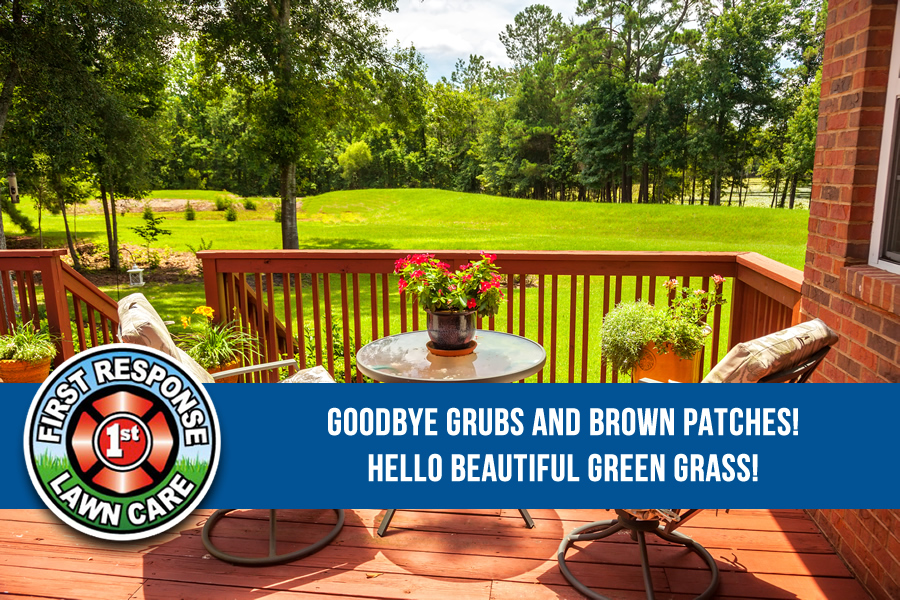
by admin | Jul 13, 2018 | Lawn Chemical Treatment Rockwall
First Response Lawn care Rockwall has your perfect concoction of chemical treatments for your lawn. We use effective and safe methods to eliminate grubs through long-lasting formulations. Our goal is not only termination, but also lawn pest prevention.
Grub control products are best applied in July, so they can impact grubs as soon as they hatch.
If you saw brown, dying patches in your lawn this Spring, chances are that you had white grubs. The cure for moving forward with a green lawn is a late-summer treatment.
The best time to treat for grubs is actually late summer, when grubs are small and more susceptible to insecticides.
White grubs are the larval stage of May or June beetles and masked chafers. Grubs are white, C-shaped with distinct, brown heads and three pairs of legs near the front end. They feed on dead organic matter and grass and plant roots. These are considered bad “bugs” since they feed on plant roots.
Adult May or June beetles are oblong, robust insects. There are many species in Texas, but most are shiny, reddish brown or dark brown, and three-quarters to 1 1/4 inches long. They are often incorrectly referred to as “Junebugs.”
Adult masked chafers resemble May beetles but are smaller and yellow brown in color. The Japanese beetle is often confused with June beetles, but Oklahoma does not have them as other states do.
May/June beetles have life cycles ranging from 1 to 3 years, but most in this area have a two-year life cycle. From April to September adults begin to emerge from the soil. Adults of most species are most common in May and June. They mate and the female lays 50 eggs in the soil.
Larvae hatch three to four weeks after eggs have been laid and feed on dead organic matter, later moving to the roots of plants. They move deeper into the soil in fall for winter. The following spring the larvae move back to the root area to feed.
Bottom line is that nobody wants grubs in their lawn feeding on their grass. Call First Response Lawn Care today and let’s get started on a lawn treatment that will eradicate those suckers!
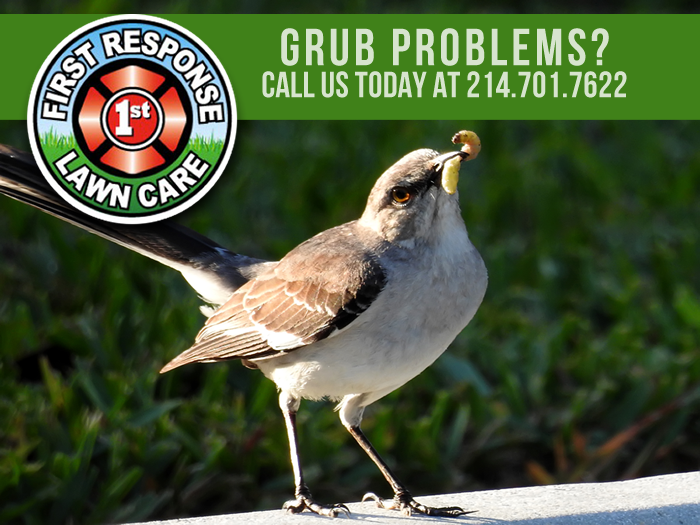
by admin | Jun 7, 2018 | Grub Control Rockwall, Grub Fungicide Rockwall
White lawn grubs are for the birds! These immature forms of different beetles, such as the Japanese beetles or June “bug” feed on grass roots (and the organic matter in the soil), causing sections of grass in the lawn to die.
Birds, skunks, armadillos, raccoons or moles will tear up your lawn to uncover and eat these grubs.
Grubs eventually turn into adult beetles and emerge from soil to mate and lay eggs, which hatch into more grubs. This typically happens in the summer months, so it is very important to get rid of the grubs before the life cycle starts. Most beetles have a one-year life cycle; June bugs have a three-year cycle. *GULP!* Generally adults emerge from soil, mate, and lay eggs over the course of two to three weeks in early to midsummer.
Depending on soil moisture and temperature, eggs hatch about two weeks after being laid, in mid- to late summer. The new generation of root-munching grubs begins feasting immediately after hatching.
How to tell if you have a grub issue –
- If you have leftover brown patches from the Spring, those dead patches may be due to grub feeding that occurred the previous fall. To check, lift a piece of your turf. If grubs are the culprit, the dead patch will roll up like a carpet, or you’ll be able to pull up the grass and see that it has no roots.
- Irregularly shaped dead patches appear in your well-irrigated lawn in late summer.
- Critters are tearing up your lawn. Birds, skunks, raccoons, etc. eat grubs and are trying to uncover them.
- Your turf has become spongy. Sometimes you can detect sponginess before extensive brown patches appear. With well-watered lawns, sponginess may be the first clue that grubs are present.
Controlling grubs in your lawn is a very time sensitive activity. The window of time to treat your lawn for grubs is now through July 14th.
The treatment is not to kill current grubs, but rather kill the grubs that are going to hatch sometime in late July, August, or September.
You have to use the correct chemical to destroy the next round of grubs that will damage your lawn in fall and next spring. Call First Response Lawn Care today and ask about our grub fungicide treatment 214.701.7622!
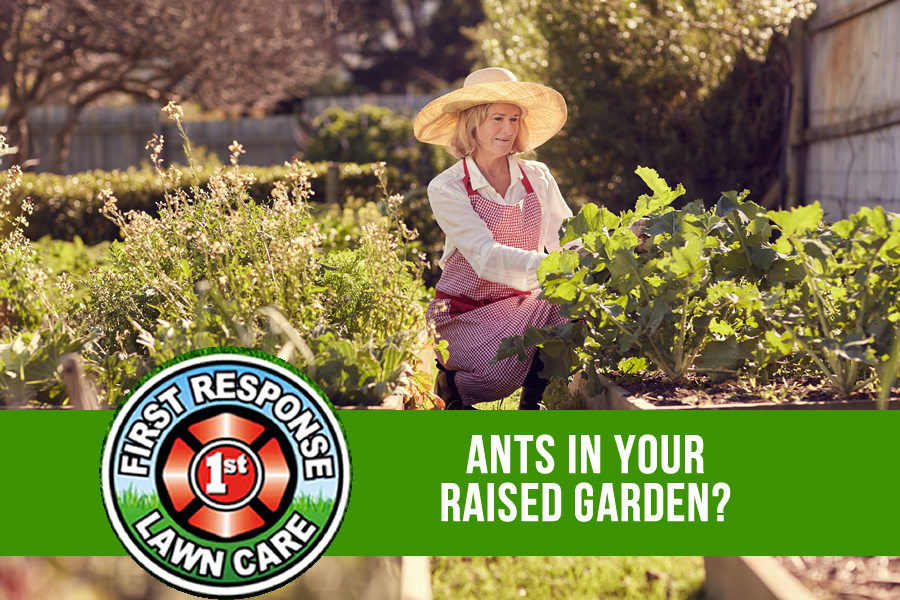
by admin | May 21, 2018 | Ant Control Rockwall Texas, Gardening Tips
We had a client who woke up to a huge ant mound in her raised vegetable garden. The grape vine and basil next to the mound was already looking droopy. She tried digging out the top mound and moving the ants to another location, but the deeper she dug, the more she realized that beneath the soil, these little insects had taken over the entire floor of the garden bed. She asked what to do to get rid of the ants naturally.
We have several suggestions, so it depends on what is most important to you. If you don’t want to kill the ants, you could place coffee grounds in the raised bed and mix them in with the soil. The acidity in the coffee will drive the ants away. The problem is that these smart insects will go somewhere else to build their colony.
Or you could sprinkle ground cinnamon where you see the ants. Cinnamon disrupts the trails the ants are making, and they’ll stop coming that way.
Coffee grounds and cinnamon are obviously not harmful to your vegetables, so these are both a great organic way to treat ants.
If your intention is to rid your veggie garden and lawn completely of ants, you could use more aggressive household products which will likely kill the ants. You could use a mixture of 1 cup of Borax, 1 cup of sugar and 1 tablespoon of water in a bowl to make a paste. Place the bowl near the ant mound. The ants are drawn into the bowl by the sugar and the Borax immediately kills them or they will take it back to the colony and it will kill the ants beneath the soil.
You might wonder if the Borax would be harmful to you since you’ll eat the veggies. The answer is that the amount carried back to the soil would be so minuscule that it would not be toxic. Borax is a naturally occurring mineral also known as sodium borate, sodium tetraborate, or disodium tetraborate. It is an important boron compound, a mineral, and a salt of boric acid.





